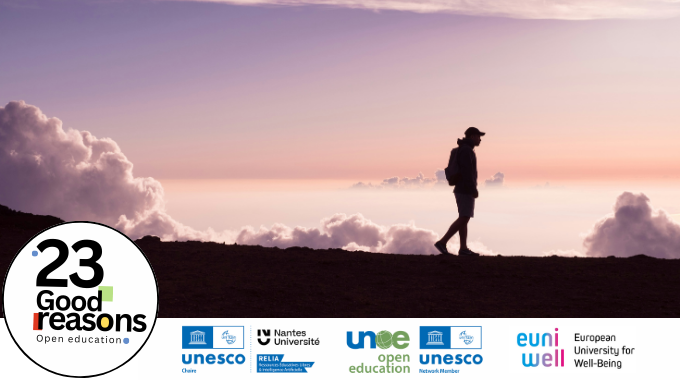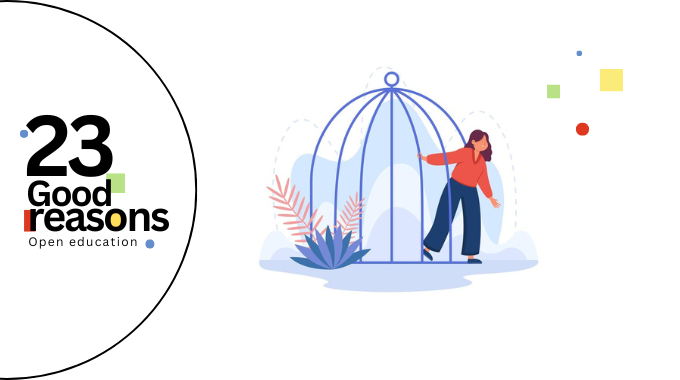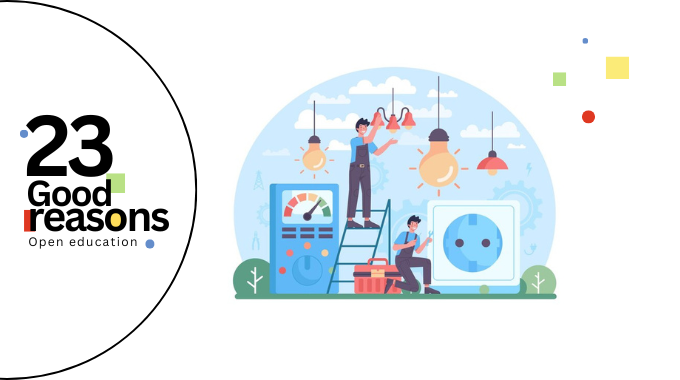Category: 23 good reasons
-
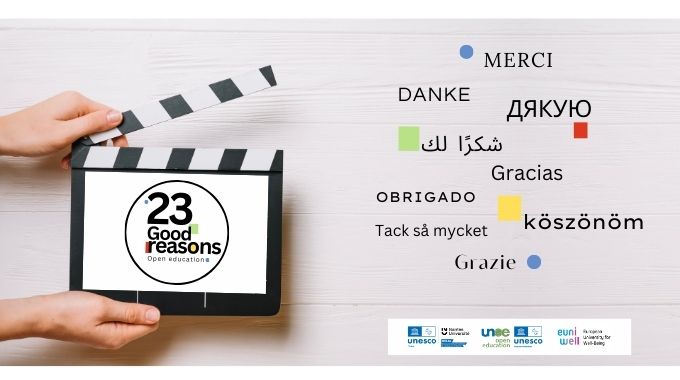
Advancing Open Learning: The Dubai Declaration and UNESCO Open Education Chairs for Accessible, Adaptable, and Relevant Learning”
Today’s article is written by Zeynep Varoglu
Zeynep Varoglu is a Senior Programme Specialist in UNESCO’s Digital Innovation and Transformation Section, focusing on Open Educational Resources and ICT Competency Framework for Teachers.
Zeynep Varoglu has been the key person coordinating, at UNESCO, the efforts on OER. She has agreed to share her global analysis and views on the new context, favourable to the development of open education. In a way, Zeynep is telling us why… it’s the right time to open up!
The Dubai Declaration on Open Educational Resources (OER), adopted at the 3rd UNESCO World OER Congress, “Digital Public Goods: Open Solutions and AI for Inclusive Access to Knowledge” (Dubai, UAE, 19-20 November 2024), offers a comprehensive framework for transforming learning through the responsible use of AI and emerging technologies. Building on the UNESCO 2019 Recommendation on OER, the Declaration addresses challenges posed by the rapid rise of generative AI, such as licensing issues for machine-generated content, data privacy and the development of AI tools to improve attribution, discoverability, and machine translation. The Declaration outlines actionable strategies that promote broader access to knowledge, educational opportunities, openness, all while ensuring the responsible integration of AI into learning.
The Dubai Declaration on Open Educational Resources (OER) emerged from a comprehensive multistakeholder collaborative effort to implement the UNESCO 2019 Recommendation on OER. Key contributions included those from Dr. Tel Amiel, UNESCO Chair in Open Education and Technologies for the Common Good, Brazil, and Dr. Javiera Atenas, Senior Lecturer at the University of Suffolk, UK, who prepared a research paper for UNESCO. The initiative was also supported by the UN Sustainable Development Solutions Network (SDSN). The Declaration was shaped by two feedback cycles from the UNESCO/Internet Governance Forum (IGF) OER Dynamic Coalition Advisory Group and six regional consultations[1] organized by UNESCO. These consultations involved approximately 900 participants from 91 countries representing governments, institutions and civil society, and provided regional insights that were integrated into the Declaration. Additionally, a six-week global open online consultation received input from 36 countries, showcasing widespread support. Further refinements occurred during the 3rd UNESCO World OER Congress, which brought together some 400 participants from 100 countries representing governments, institutions and civil society from all UNESCO world regions.
The Dubai Declaration’s emphasis on leveraging technology for openly licensed learning content aligns closely with the mission of the UNESCO UNITWIN Network of Open Education Chairs (UNOE). The Network serves as an essential hub for research, advocacy, and capacity-building, working to create an educational ecosystem that remains open, accessible, and adaptable to the needs of diverse learners. It plays a pivotal role in advancing the goals of the Dubai Declaration by fostering a future where inclusivity, equity, and collaboration are fundamental to learning.
Harnessing Technology for Good and Advancing Digital Public Goods
The Dubai Declaration serves as a strategic guide for UNESCO Member States to leverage openly licensed learning content and integrate AI and emerging technologies into the OER ecosystem. It stresses the importance of digital public goods, as outlined in the UN Secretary-General’s Roadmap for Digital Cooperation, which includes open-source software, open data, AI models, standards, and content that comply with privacy laws, do no harm, and contribute to achieving the SDGs. The Declaration highlights several key focus areas:
- Generative AI in Learning: The Declaration advocates for responsible frameworks and open licensing to enable the use of generative AI tools in creating educational content, including textbooks, multimedia resources, and course materials. This approach emphasizes transparency and addresses copyright concerns, contributing to the expansion of digital public goods in learning.
- Data Privacy: The Declaration stresses the need to safeguard personal data while promoting the open exchange of knowledge. It calls for policies that protect user data while ensuring that digital resources remain accessible and secure, which is in line with OER principles.
- Attribution Systems and Discoverability: The Declaration supports the development of AI tools that ensure fair attribution of open educational content. Proper attribution systems are essential for building trust in OER, allowing creators to retain credit for their work while making resources globally accessible.
- Machine Translation: AI-powered translation tools are essential for overcoming language barriers in learning. The Declaration emphasizes that these tools must be open, accurate, and culturally sensitive, promoting equitable access to education for learners worldwide.
To address these challenges, the Dubai Declaration advocates for continued international collaboration, research, and the development of flexible policies that support digital public goods and foster inclusive, equitable learning.
UNESCO Open Education Chairs: Supporting the Dubai Declaration’s ImplementationThe UNESCO UNITWIN Network of Open Education Chairs is central to advancing the goals outlined in the Dubai Declaration. The network serves as a dynamic hub for research, advocacy, and capacity-building, supporting the integration of OER and open educational practices into higher education systems globally. By leveraging emerging technologies, the network fosters openness and inclusivity in learning.
Key roles of the UNESCO UNITWIN Network of Open Education Chairs include:- Research and Policy Development: The Network leads research initiatives that inform the development of evidence-based policies for open learning. Its work offers critical insights into how AI and emerging technologies can be integrated into OER, addressing key issues such as copyright, data security, and fair attribution.
- Building Capacity for Open Learning: The Network plays a vital role in training educators and institutions to adopt open educational practices, thereby strengthening the global open learning ecosystem.
- Global Collaboration and Advocacy: The Network promotes international collaboration by sharing best practices and lessons learned globally. This collaboration supports the Dubai Declaration’s call for enhanced global cooperation and helps advance open learning worldwide.
ConclusionThe Dubai Declaration on OER provides a robust framework for transforming learning through technology and openness. The UNESCO UNITWIN Network of Open Education Chairs is instrumental in implementing the framework by supporting research, capacity-building, and global collaboration. Through the integration of AI and emerging technologies into open learning, the Network contributes to building a more inclusive, resilient, and participatory learning environment. The UNESCO UNITWIN Network of Open Education Chairs has an important role to play in ensuring that knowledge remains accessible, adaptable, and relevant to the needs of an increasingly digital world.
[1] These regional consultations were held online and in hybrid format, as follows: the Africa consultation (hybrid, at eLearning Africa 2024, 31 May 2024); the Caribbean consultation (online, 10 July 2024); the Asia and the Pacific consultation (online, 30 July 2024); the Europe and North America consultation (hybrid at Digital Learning Week, UNESCO, 4 September 2024); the Latin America consultation (online, 8 October 2024); and the Arab States consultation (online, 21 October 2024).
“
Advancing Open Learning: The Dubai Declaration and UNESCO Open Education Chairs for Accessible, Adaptable, and Relevant Learning”
” by Zeynep Varoglu is licensed under CC BY 4.0
-
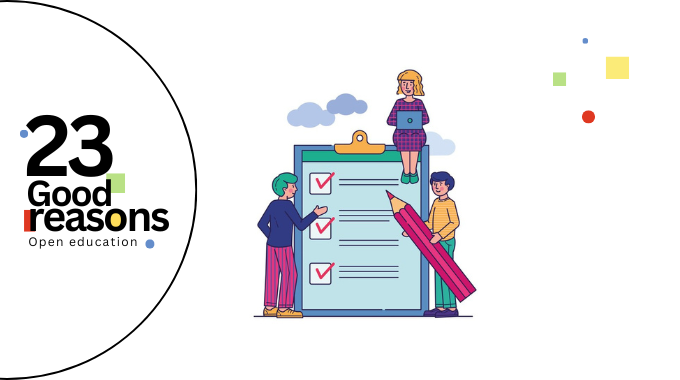
Assess fairly
Today’s article is written by Lilia Cheniti Belcadhi
Dr Lilia Cheniti Belcadhi, Senior Lecturer in Computer Science at the University of Sousse, Tunisia, researcher in Educational Technologies and AI. She is an OER ambassador to the International Council for Open and Distance Education (ICDE), a member of the International Scientific Council of the AUF (Agence Universitaire de la Francophonie) and Vice-President of the International Network for Educational Innovation and Training of Trainers, responsible for higher education.
Open education is based on accessibility, transparency and collaboration to promote more inclusive and participatory learning. It aims to improve teaching and learning through pedagogical practices based on sharing, collaboration, open access and reuse.
Open assessment is considered to be an educational practice that aims to improve learner participation as a key participant in the learning process (peer learning), encouraging commitment to learning and increasing the validity and reliability of assessment activities through the implementation of actions and continuous formative feedback. There are three main forms of assessment: diagnostic assessment at the beginning of a learning process, summative assessment at the end of learning and formative assessment to identify the progress made by the learner. All these forms of assessment are essential to understanding what students learn during a learning activity.
By adopting open assessment practices for the different forms of assessment, it is possible to ensure a process based on transparency and fairness, through the sharing of assessment grids, indicating the adopted assessment criteria. Learners also have access to feedback and corrections of their work, which ensures fairness in the assessment of their performance. In addition, the feedback provided on learners’ work can provide them with a variety of information to help them progress in their learning process.
Designing and implementing an open assessment process also helps develop a culture of continuous improvement among learners thanks to the constructive feedback they receive, thus giving them the opportunity to modify and improve their work based on the comments shared with the learning community. Open assessment also promotes the establishment of a collaborative learning framework, in particular through peer assessment activities, which enable learners to engage in an active learning process and emphasise reflective practices and the improvement of results. Learners thus develop skills such as critical thinking and the ability to give and receive constructive feedback on shared work.
The use of technologies for open assessment facilitates the creation of assessment resources, their reuse and their sharing by learning communities. These technologies thus facilitate the creation of open, interactive and participatory assessment environments, integrating spaces for online discussion and the sharing of comments and feedback, which increases the motivation and engagement of learners. The figure below highlights open assessment in a framework of open pedagogical practices. It emphasises teacher-OER interaction through formative assessment and the creation of renewable tasks, i.e. tasks in which learners openly produce and publish their work so that it can be reused and shared by the learning community.
Adapted from: A Case Study of Applying Open Educational Practices in Higher Education during COVID-19: Impacts on Learning Motivation and Perceptions by Zhang, et. al, (CC BY 4.0).
Furthermore, it is important to note that effective assessment cannot be a ‘one-size-fits-all’ approach in which the same assessment strategy is applied to all learners. Learners are different and it is important to direct the learner to the content most appropriate to their needs through personalised assessment. This requires a flexible and open evaluation process in which adapted and personalised evaluation strategies can be applied. Artificial intelligence technologies provide new possibilities for learners and enable continuous monitoring, facilitation of open and collaborative evaluation and automatic analysis of discussions and comments received.
In conclusion, it is important to note that open assessment contributes to enriching learning by promoting a transparent and collaborative process, based on a participatory approach, allowing learners to be engaged and motivated.
-
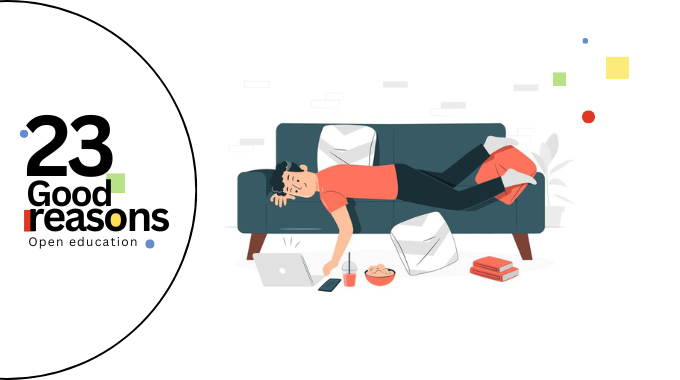
Deal with agency issues
Open education and the power of agency
Today’s article is written by Dorothy Laubscher
Dorothy Laubscher is an associate professor in the Research Unit Self-Directed Learning at the North-West University, South Africa. She holds the UNESCO Chair on Multimodal Learning and Open Educational Resources at the North-West University. Her research interests include mathematics education, technology-enhanced learning, self-directed learning, open education, open educational resources, and blended and multimodal learning environments to foster self-directed learning.
The promise of open education is inspiring – learning without barriers, resources freely available to all, and a system that fosters collaboration and innovation. By making knowledge accessible beyond traditional institutional constraints, open education has transformed how we teach and learn. Yet, beyond its role in expanding access, open education offers something even more powerful: agency.
In traditional education systems, control often rests with institutions, publishers, and curriculum designers, leaving both facilitators and students with limited flexibility. Open education challenges this model by giving people real choices in how they teach and learn. It not only makes knowledge available but also empowers individuals to shape, adapt, and direct their own educational experiences. In many ways, open education provides a compelling solution to long-standing agency issues in education, allowing for more personalised, flexible, and inclusive learning.
I have experienced how open education can strengthen agency in ways that traditional systems often cannot. Coming from the Global South, I have noted the challenges of working with educational resources that, while freely available, do not always align with local realities. A university lecturer eager to integrate Open Educational Resources (OER) into their teaching may find that the materials are designed for contexts vastly different. The ability to adapt and remix those materials makes all the difference, ensuring that education is not just open, but meaningful. Similarly, students who engage with OER can explore topics at their own pace, following their interests rather than being confined to rigid learning pathways. Open education fosters an environment where facilitators and students are not just passive recipients of knowledge but active participants in creating and shaping it (Heymans et al., 2022).
This shift is particularly important in diverse learning environments. Many widely used textbooks and OER originate from well-resourced regions, meaning that they may not always reflect the cultural and linguistic diversity of learners worldwide. As someone from the Global South, I have seen how this creates challenges, not only in terms of accessibility but also in representation. Open education allows for localisation and contextualisation, ensuring that knowledge is inclusive and relevant to different educational and socio-cultural settings. By giving facilitators the freedom to modify materials, open education enables them to create richer, more meaningful learning experiences that resonate with their students’ needs and realities.

For students, open education provides an opportunity to move beyond the constraints of traditional education. Self-directed learning (SDL) thrives in open environments (Tarling & Gunness, 2021), where students can explore subjects in a way that suits their needs, rather than following a pre-set curriculum. Unlike conventional courses that dictate a fixed sequence, OER allow students to engage flexibly, choosing when, how, and what to learn. This freedom of choice is central to student agency, enabling students to take control of their education, make decisions about their learning pathways, and engage with knowledge in ways that are personally meaningful. Open education not only supports access but also fosters essential SDL skills, such as goal-setting, self-motivation, and the ability to critically evaluate and apply knowledge independently.
“Students collaborating (8611243532)” by college.library is licensed under CC BY 2.0.
Technology is playing an increasingly significant role in supporting agency within open education. AI-driven tools, for instance, can personalise learning experiences by recommending relevant resources and generating adaptive content. However, technology must be designed to enhance rather than limit agency. If AI-driven platforms begin to dictate learning pathways too rigidly, learners may lose the very flexibility that makes open education so valuable. The key is to use technology as a tool for empowerment, ensuring that learners and educators remain in control of their educational choices. Despite the challenges, open education has already demonstrated its potential to transform access to knowledge into something even greater – ownership over learning. Facilitators can create and customise resources that meet their students’ needs. Institutions can foster collaboration and innovation in knowledge creation. Students can take charge of their learning, engaging with open materials not just as consumers but as co-creators of knowledge (Androsov & Zhang, 2023).
A truly open system is one where knowledge is not just available but adaptable, diverse, and student-centred. As open education continues to evolve, the key question remains: Does this approach give students and facilitators more freedom to shape their own educational experiences? If the answer is yes, then open education is not just providing access, it is providing agency. And in that lies its greatest strength.
References
Androsov, A., & Zhang, B. (2023). Students as Co-Creators: Bringing Culturally Responsive Teaching into a Doctoral Course for International Students in China. Sage Open, 13(1). https://doi.org/10.1177/21582440221145914
Heymans, Y., Pool, J., Bisschoff, C., Christmals, C., Ebrahim, B., Koch, R., & Olivier, J. (2022). Second-year health students’ perspectives on developing open educational resources. In J. Olivier, C. du Toit-Brits, B. J. Bunt, & A. Dhakulkar (Eds.), Contextualised open educational practices: Towards student agency and self-directed learning (pp. 157–174). AOSIS Books. https://doi.org/10.4102/aosis.2022.BK345.08
Tarling, I., & Gunness, S. (2021). Educators’ beliefs, perceptions and practices around self-directed learning, assessment and open education practices. Radical Solutions for Education in Africa: Open Education and Self-directed Learning in the Continent, 187-209.
-
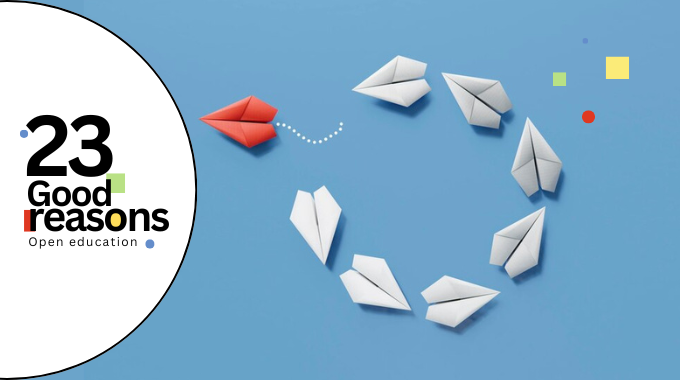
Incentivize original thinking
Today’s article is written by Djaine Damiati, Isabela Menezes & Debora Sebriam
Djaine Damiati (associate researcher) and Isabela Menezes (designer) are part of the UNESCO Chair in Open Education and Technologies for the Common Good (University of Brasília, UnB) which is part of the Unitwin network UNOE.
Debora Sebriam is member of the Open Education Initiative research group at UnB.
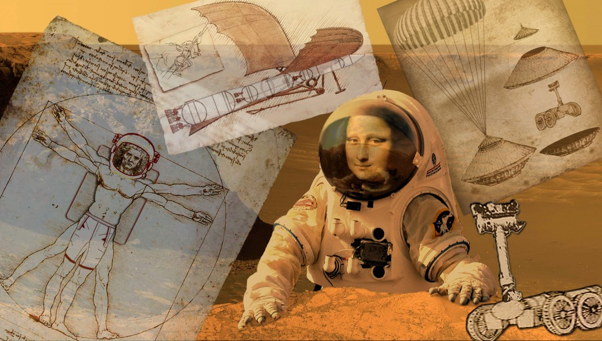
The concept of geniality and the idea of creative innovation took center stage in the Renaissance, amid a social imaginary that drove discoveries and inventions such as the heliocentric theory, the astrolabe, the geometric perspective, and others that, to this day, lay the foundations of the humanity’s technical and scientific framework (Burckhardt, 1990).
In the modern era, the idea of innovation has continued to be a kind of driving force behind the ideals of development in Western societies (Schumpeter, 1988), and although this notion has changed over time, starting from a vision exclusively focused on technical progress, later to encompass other aspects such as sustainability and social impact (Plonski, 2017), encouraging the ability of thinking originally and stimulating creation has never been so demanded and valued as it is today, shaping practices and processes in different social spheres, including the field of education.
Image: Da Vinci Mona Lisa funny technology. Creative Commons Attribution-Share Alike 4.0 International license.
Seeking to align teaching-learning processes with the ideal of valuing original thinking as the basis for building technical-scientific knowledge and innovation processes, between the 20th and 21st centuries, different theoretical and methodological approaches to education discussed and proposed ways of encouraging original thinking and creativity in the most diverse contexts. From the most classic to the most innovative, these approaches provide foundations for what is characterized as ways of encouraging original thinking and creativity. Among these are the following:
(1) Active role of the individual – Original thinking is encouraged when people face real problems and are encouraged to formulate their own hypotheses, experiment with solutions, and reflect on the results found (Dewey, 2023);
(2) Autonomy and criticality – The more individuals are involved as beings in the world, the more they will feel challenged (Freire, 1997, 2002);
(3) Collaboration and dialogue – Collaborative learning and group work favour the development of complex cognitive skills and creativity (Vygotsky, 1986), and the teaching process based on debates challenges preconceived ideas and creates an environment conducive to exploring one’s own ideas (Postman & Weingartner, 1969).
(4) Flexibility and adaptability – when education is adaptable to people’s needs and interests, it favours the development of creativity, critical thinking, and innovation (Dewey, 2023);
(5) Exploration and experimentation – people who are actively involved in creating something learn better (Papert, 1980; Postman & Weingartner, 1969).
Open Education has characteristics that dialogue with all the foundations mentioned since it encourages:
- inclusion by valuing different experiences and knowledge, broadening cultural and intellectual repertoire;
- adaptability which allows adaptations of educational resources to meet local needs and realities;
- collaboration and sharing favouring the collective construction of knowledge, leading individuals to refine and innovate in their own creations;
- open access allowing more people to explore, question and build on existing ideas, fostering creativity and the production of new thoughts;
- open technologies allowing users to explore and develop projects autonomously and innovatively.
The notion of original thinking has changed a lot. One of the reasons is the profusion of information and forms of collaboration provided by the web, which has meant that original thinking has opened up more space for forms of remix.
The concept of remix refers to the act of creatively recombining, reinterpreting, and transforming content that already exists, generating new meanings, learning and perspectives (Amiel, 2014). Thus, the idea of originality is no longer necessarily linked to what is new, but to what acquires value in new contexts.
In elaborating on one of the most influential principles of pragmatist philosophy, semiosis, Peirce stated that signs do not arise from nothing, but are linked in a continuous network of meanings, so every representation or interpretation will depend on other signs (Peirce, 1931-1958). This is the popular idea that ‘nothing comes from nothing’, later adopted by other philosophical currents in the West and reinforced contemporaneously by authors such as Austin Kleon who states: ‘All creative work is built on what has come before. Nothing is totally original’ (Kleon, 2012).
The very concept of innovation has suffered a notable influence from this new paradigm, and today, different authors position it much closer to the ability to generate value with changes capable of responding to certain needs, rather than the creation of the new per se. This perspective is aligned with the principles of Open Education, which in this scenario is gaining strength and becoming an instrument of innovation. Encouraging the creation and remixing of educational resources and practices promotes the development and sharing of new solutions, solving common problems and stimulating innovative thinking to adapt and create specific solutions for different local realities.
In this way, Open Education not only democratizes access to knowledge but also stimulates creativity, autonomy, and critical thinking, consolidating itself as an essential pillar for the development of more inclusive and innovative societies.
References
Amiel, T. (2014). O uso do remix na educação e as novas formas de produção de conhecimento. Revista Brasileira de Educação, 19(60), 587-603.
Burckhardt, J. (1990). A civilização do Renascimento na Itália (G. L. Aranha, Trad.). Editora Unesp. (Original work published in 1860).
Christensen, C. (1997). The Innovator’s Dilemma: When New Technologies Cause Great Firms to Fail.
Dewey, J. (2023). Experience and Education. Editora Vozes.
Freire, P. (1987). Pedagogia do oprimido (21ª ed.). Paz e Terra. Available from: https://pibid.unespar.edu.br/noticias/paulo-freire-1970-pedagogia-do-oprimido.pdf/view
Freire, P. (2002). Pedagogia da autonomia: Saberes necessários à prática educativa (25ª ed.). Paz e Terra.
Furtado, D., & Amiel, T. (2019). Guia de bolso da educação aberta. Iniciativa Educação Aberta.
Kleon, A. (2012). Steal like an artist: 10 things nobody told you about being creative. Workman Publishing.
Papert, S. (1980). Mindstorms: Children, computers, and powerful ideas. Basic Books.
Peirce, C. S. (1931-1958). The Collected Papers of Charles Sanders Peirce. Vol. 2, Elements of Logic. Harvard University Press.
Postman, N., & Weingartner, C. (1969). Teaching as a subversive activity. Delacorte Press.
Vygotsky, L. S. (1986). Thought and language (A. Kozulin, Trans. & Ed.). The MIT Press.
“
Incentivize original thinking
” by Djaine Damiati, Isabela Menezes & Debora Sebriam is licensed under CC BY 4.0
